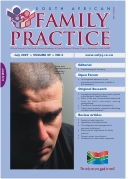An intergrated approach to health promotion in the workplace: A review from international experience
Keywords:
Intergrated, approach, workplace, prevention, health promotion, programmen
Abstract
This paper reports the results of a review of health promotion programmes in the workplace. The aim of this review was to ascertain evidence of success in health promotion in the workplace. Workplace health promotion (WHP) programmes help to improve employee health by optimising an organisation’s overall economic, structural and cultural environment. It also tends to reach the healthy workers at the best companies, which are employing the healthier individuals in the formal sectors of the economy. The workplace is viewed as an effective setting for health promotion in order to achieve the goal of “Health for All, and for other benefits such as reducing and controlling healthcare costs as a result of the growing epidemics of communicable and non-communicable diseases. Strategies to facilitate workplace health promotion include health education, behaviour-directed prevention, and incorporating the organisation’s development strategy into human resources policies to make prevention the essential part of the entire corporate strategy. A healthy, motivated and contented workforce is fundamental to the future social and economic wellbeing of any nation. The protection of employees against exposure to various occupational hazards can be achieved through implementing integrated programmes to improve employees’ wellness and promoting a health- and safety-oriented culture in the workplace.
Published
2007-07-04
Issue
Section
Forum
By submitting manuscripts to SAFP, authors of original articles are assigning copyright to the South African Academy of Family Physicians. Copyright of review articles are assigned to the Publisher, Medpharm Publications (Pty) Ltd, unless otherwise specified. Authors may use their own work after publication without written permission, provided they acknowledge the original source. Individuals and academic institutions may freely copy and distribute articles published in SAFP for educational and research purposes without obtaining permission.

